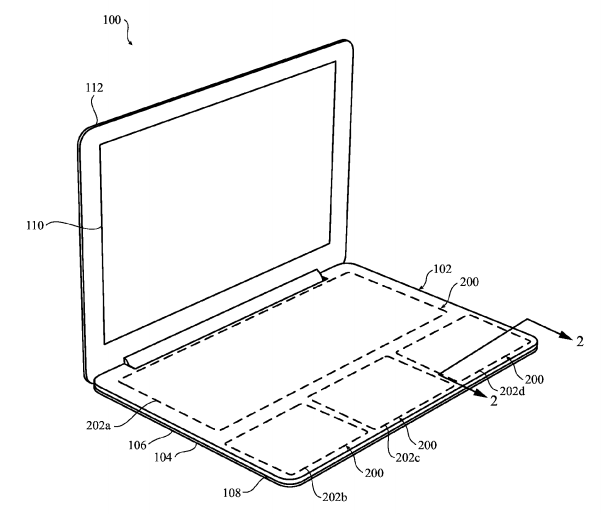Full Size Zero-Travel Touch Keyboard Concept For MacBook Pro Not So Far-Fetched – The ‘Book Mystique
I’m no fan of the 2016 MacBook Pro’s Touch Bar or its second generation but still clunky and compromised butterfly switch keyboard. The Touch Bar is an answer to a question nobody asked, and many find typing on the ultrathin keyboard uncomfortable.
However, a third-party design concept for a 2018 MacBook Pro by Seattle, Washington based industrial design student Daniel Brunsteiner, posted by Yanko Design, an online magazine featuring the best in international product design, points to a way Apple’s Touch Bar technology could be made actually useful and the MacBook Pro keyboard issue be addressed elegantly and simultaneously.
Colored has also published a portfolio of Brunsteiner’s design concept views.
Yanko Design’s Troy Turner notes that the concept explores integration of a full-size virtual keyboard based on Touch Pad technology displacing the traditional electromechanical keyboard entirely. The new zero-travel input medium would harness Apple’s Taptic Engine system to simulate the feel of physical buttons or even of scroll wheels or sliders. A discrete Touch Bar would be retained for shortcuts and function keys but the entire main keypad surface would be touch enabled.
This isn’t as far-fetched as it may sound. Last year Apple was granted a patent for a “configurable, force-sensitive input structure for an electronic device,” which in plainer English is a capacitive keyboard that could be used in laptop computers instead of the traditional physical keyswitch type keyboard. Essentially, it would bring tablet-style virtual keyboard input to laptops, with the addition of haptic “motion” feedback even though the user would be striking zero-travel “keys” on a flat plane — sounding very much like what Daniel Brunsteiner’s concept proposes.
I can’t say for sure, having never used such a setup, but my inference is that I would like it better then the butterfly keyboard, and I don’t mind using the virtual keyboard in my iPad Air 2, although on a 9.7-inch panel in landscape mode you do lose half or more of the screen’s depth to accomodate the keyboard. That would not be an issue with a capacitive ‘zero-travel’ keyboard located on the lower plane of a clamshell laptop form factor. Consequently, this is a concept I think I could happily embrace, and I hope Apple will proceed with something like it
Advantages of a zero-travel haptic feedback keyboard would include enabling of iOS style custom keyboard layouts that could change to optimize them for the application in use. a glass keypad with no openings would facilitate a drastic reduction in moving parts, elimination of the mechanical wear factor and increased resistance to dirt and/or moisture ingress. The butterfly keyboards used in the MacBook Pro and 12-inch MacBook have proved particularly vulnerable to getting gummed up with particles of dirt and food that gain entry through the key cap apertures.
The abstract published with United States Patent Application 20160098107 specifically mentions this as an important issue, noting that because conventional laptop keyboards typically have components positioned both inside and outside the device enclosure, such as keycaps protruding from the housing, corresponding internal dome switches and electrical contacts and traces located inside the enclosure, they are susceptible to damage from debris and other contaminants that will inevitably enter the device enclosure, potentially damaging internal components. Moreover, if a single component is damaged, lost, or quits working, the entire input device may become inoperable. Likewise, mechanical input device components may be especially vulnerable to a drop or mechanical shock.
Other benefits of capacitive touch input keyboards in laptops would be presumed lower-cost, and with Apple’s thin device obsession — potential for even slimmer laptops than the current 12-inch MacBook.
Keyboard characteristics preferences are highly subjective, and capacitive ‘boards have many detractors, particularly among touch typists, whom haptic feedback might help to win over.
Some folks, my touch typist wife for instance, prefer old-school keyboards with “clicky” mechanical keyswitches, relatively stiff key action an long key travel. Personally, I prefer quiet keys with short travel and very light and smooth action, a soft landing, and a minimum of “over-center” feel.
The evolution of keyboards used in Apple laptops has been somewhat uneven, in recent years complicated by Apple’s obsessive pursuit of form factor thinness.
The ‘boards in the original 100-series and Duo PowerBooks were OK in the context of the day, but nothing special. The 500, 5000, 3400, and original G3 series PowerBook keyboards were better, but still nothing to get up in the night and write home about. The PowerBook 1400 was an exception to late-’90s keyboard mediocrity, having a very nice action and feel. A major revolution came with Apple’s adoption of scissors-action keys that had been pioneered in the IBM-Japan built PowerBook 2400c subnotebook in the mid-’90s and used in the PowerBook G3 Series WallStreet, whose keyboard probably has my vote as best Apple laptop ‘board ever, although the subsequent G3 Series Lombard and Pismo PowerBook families had excellent scissors-action keyboards as well.
For some reason, I never found the keyboards in the titanium and aluminum PowerBook G4 models as comfortable as the G3 Series ‘boards, even though they used similar technology, and I disliked the keyboard in my white 2003 iBook, which may have been Apple’s worst-ever laptop ‘board until the butterfly keyswitch ‘boards in the 12-inch MacBook and 2016 MacBook Pros were rolled out.
I’ve become quite partial to the so-called “chiclet” keyboards introduced with the aluminum unibody MacBooks and MacBook Pros in 2008, and the examples in my two 13-inch MacBook Airs are particularly good — substantially better than the one in my late 2008 aluminum MacBook.
Capacitive, zero-travel haptic feedback keyboards in Apple notebooks would make more sense of Apple’s Touch Bar technology, and might also justify Apple’s stubborn rejection of putting touchscreens in laptops. Daniel Brunsteiner’s concept demonstrates how elegant such a machine could be. Let’s hope Apple makes the idea a reality.

